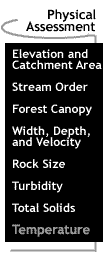
 Water
Quality Assessment: Physical: Temperature
Water
Quality Assessment: Physical: Temperature
The most common
physical assessment of water quality is the measurement of temperature.
Temperature impacts both the chemical and biological characteristics of
surface water. It affects the dissolved oxygen
level in the water, photosynthesis of
aquatic plants, metabolic rates of aquatic organisms, and the sensitivity
of these organisms to pollution, parasites and disease.
Thermal pollution is the introduction of water that is warmer than the body of water into which it flows. It generally occurs near power plants. These industries discharge hot water that has been used to cool equipment directly into streams. Another source of thermal pollution is urban runoff. This is water that has been heated as it flowed over parking lots, streets and sidewalks. Plowing near streams or the removal of the forest canopy during construction also contributes to thermal pollution by decreasing shade, thereby increasing solar heating of the water's surface. In addition to increasing the amount of solar radiation reaching the water's surface, removal of vegetation near streams often results in increased erosion and increased amounts of sediments in the water. The sediments absorb heat from sunlight rather than reflect it. This heats the water further. Image © 1999 -www.arttoday.com
Warm water is less capable of holding dissolved oxygen. For this reason, temperature should be measured at the same place within the stream at which dissolved oxygen is measured. This allows the correlation between the two parameters to be observed.
The problem of low dissolved oxygen levels is magnified by the fact that the metabolic rates of aquatic plants increase as water temperature rises, thus increasing their biochemical oxygen demand. Low dissolved oxygen levels leave aquatic organisms in a weakened physical state and more susceptible to disease, parasites, and other pollutants.
Overview ..|.. Biological Assessment ..|.. Chemical Assessment ..|.. Physical Assessment.
Elevation
and Catchment Area / Stream Order /
Forest Canopy / Width,
Depth, and Velocity / Rock Size / Turbidity
/ Total Solids / Temperature Home
..|..
Teacher Pages
..|..
Modules
& Activities
Glossary .|.
Related Links
.|..
References
..|..
PBL Model
.|
HTML code by Chris Kreger
Maintained by ETE Team
Last updated November 10, 2004
Some images © 2004 www.clipart.com
Privacy Statement and Copyright © 1997-2004 by Wheeling Jesuit University/NASA-supported Classroom of the Future. All rights reserved.
Center for Educational Technologies, Circuit Board/Apple graphic logo, and COTF Classroom of the Future logo are registered trademarks of Wheeling Jesuit University.
